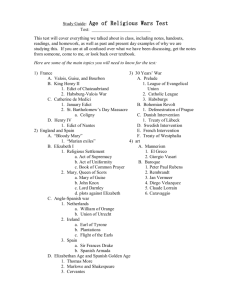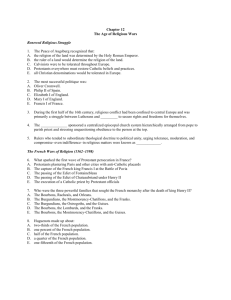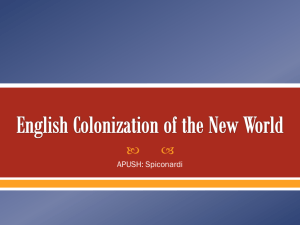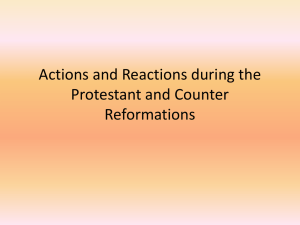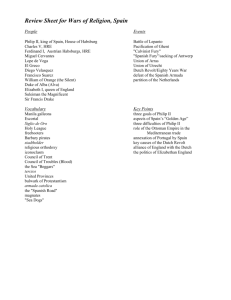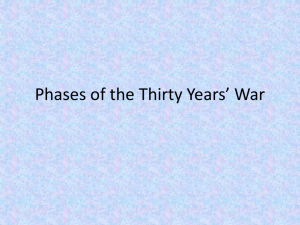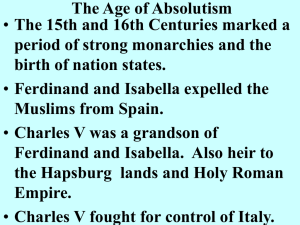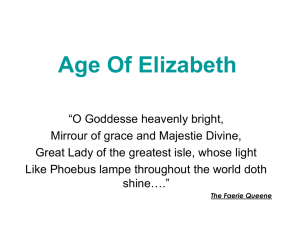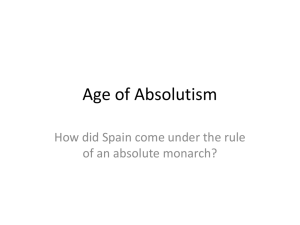Worksheet
advertisement
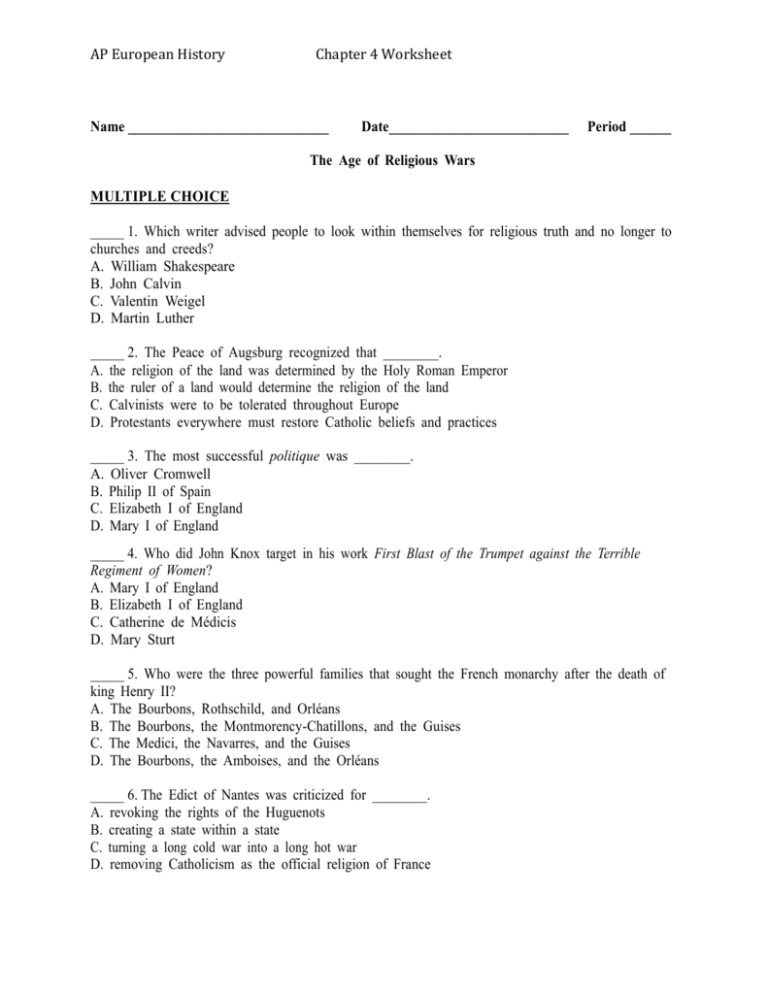
AP European History Chapter 4 Worksheet Name _____________________________ Date__________________________ Period ______ The Age of Religious Wars MULTIPLE CHOICE _____ 1. Which writer advised people to look within themselves for religious truth and no longer to churches and creeds? A. William Shakespeare B. John Calvin C. Valentin Weigel D. Martin Luther _____ 2. The Peace of Augsburg recognized that ________. A. the religion of the land was determined by the Holy Roman Emperor B. the ruler of a land would determine the religion of the land C. Calvinists were to be tolerated throughout Europe D. Protestants everywhere must restore Catholic beliefs and practices _____ 3. The most successful politique was ________. A. Oliver Cromwell B. Philip II of Spain C. Elizabeth I of England D. Mary I of England _____ 4. Who did John Knox target in his work First Blast of the Trumpet against the Terrible Regiment of Women? A. Mary I of England B. Elizabeth I of England C. Catherine de Médicis D. Mary Sturt _____ 5. Who were the three powerful families that sought the French monarchy after the death of king Henry II? A. The Bourbons, Rothschild, and Orléans B. The Bourbons, the Montmorency-Chatillons, and the Guises C. The Medici, the Navarres, and the Guises D. The Bourbons, the Amboises, and the Orléans _____ 6. The Edict of Nantes was criticized for ________. A. revoking the rights of the Huguenots B. creating a state within a state C. turning a long cold war into a long hot war D. removing Catholicism as the official religion of France AP European History Chapter 4 Worksheet _____ 7. The ruler of Spain for most of the later 1500s was _________. A. Philip II B. Ferdinand I C. Charles V D. Carlos I _____ 8. What is William of Orange known for? A. He led the movement for the independence of the Netherlands from Spain. B. He led the Turks against Spain. C. He was the captain of the Spanish Armada. D. Along with the Duke of Alba, he suppressed the Protestant revolt. _____ 9. Hostilities between Spain and England reached a climax in 1588 when ________. A. Henry III was assassinated B. Henry IV was assassinated C. the Edict of Nantes was signed D. the Spanish Armada was sent to invade England _____ 10. During the first half of his reign, Philip II focused on ________. A. events in Germany B. the Netherlands C. the Mediterranean and the Turkish threat D. the growth of English power _____ 11. What was the reaction from Europe when the Turks invaded Austria? A. The Spanish under Philip II allied with Venice, Genoa, and the pope to defend Europe against the Turks. B. Europeans largely ignored the invasion and allowed Austria to be taken over. C. The Greeks stepped up to defend Austria and defeat the Turks. D. The Huguenots came to the aid of Austria in hopes of gaining momentum for their resistance movement. _____ 12. Who was deposed after only a few days on the throne as Edward VI’s chosen successor in England? A. Lady Jane Grey B. Mary Tudor C. Elizabeth D. Mary Queen of Scots _____ 13. Queen Elizabeth I was cautious and firm with groups such as the ________ ensuring that nothing lessened the hierarchical unity of the Church of England. A. Catholics B. Puritans C. Congregationalists D. Jews AP European History Chapter 4 Worksheet _____ 14. Bavaria was a major center of _______. A. Calvinist power B. Lutheran power C. Catholic power D. Anabaptist agitation _____ 15. The Thirty Years’ War began as a(n) ________. A. peasant uprising in Germany B. trade war between Bohemia and Saxony C. revolt of Bohemian Protestant nobility against an unpopular king D. border dispute between Bavaria and Austria _____ 16. By 1600, the population of the Holy Roman Empire was about ________. A. equally divided between Catholics and Protestants B. 30 percent Catholic C. 70 percent Catholic D. 40 percent Protestant _____ 17. The Treaty of Westphalia finally granted Calvinists _________. A. legal recognition B. the power to fortify their towns C. the authority to gather in public D. the permission to worship within the borders of cities _____ 18. What did Mary I of England, Philip II of Spain, and Oliver Cromwell all have in common? A. They were all Protestants. B. They were all considered politiques. C. They all sacrificed their political goals by refusing to compromise on religion. D. They gained their religious goals and successfully restricted religious worship in their own lands. _____ 19. What did the provision in the Edict of Nantes that allowed citizens to maintain fortified towns reveal about social conditions? A. Protestants and Catholics did not trust one another. B. Protestants still had to worry about assembling to worship. C. The threat of Spanish invasion remained real. D. Protestants had been restricted from entering public universities. _____ 20. The Treaty of Cateau-Cambrésis ended the ________. A. Habsburg-Valois wars B. Thirty Years’ War C. conflict between Spain and the Netherlands D. Saint Bartholomew’s Day Massacre AP European History Chapter 4 Worksheet _____ 21. Catherine de Médicis convinced the king to execute the Protestant leaders in the Saint Bartholomew’s Day Massacre because she claimed that _______. A. the Guise family had plotted to kill him and take the throne for themselves B. a Protestant coup was afoot, and that he must save the crown from an attack on Paris C. she had been plotting an assassination of Coligny D. the Huguenots had already massacred thousands of peasants _____ 22. The French monarchy was hostile towards Protestants until ________. A. the Peace of Saint-Germain-en-Laye B. the Saint Bartholomew’s Day Massacre C. Henry of Navarre came to power D. Elizabeth I provided financial and military support for their cause _____ 23. What event starkly marked the beginning of the French wars of religion? A. the death of Francis II B. the issuing of the January Edict C. the leak, to the Catholics, of a kidnapping plot to take Francis II from his Guise advisors D. the duke of Guise surprising a Protestant congregation in Champagne and massacring many worshipers _____ 24. King Henry IV stunned France, Spain, and the pope by ________. A. publicly abandoning the Protestant faith and embracing Catholicism B. publicly abandoning the Catholic faith and embracing Protestantism C. declaring France Protestant, but hoping it would remain politically weak D. declaring France Catholic, but hoping it would remain politically weak _____ 25. What were the original goals of Cardinal Granvelle when he led the special council of state in the Netherlands? A. establish local autonomy for the seventeen Netherlands provinces B. decentralize the government and put it in the hands of a Dutch ruler C. destroy any threats to Margaret of Parma and to establish her as the ruler of the Netherlands D. break down local autonomy and build a central royal government directed from Madrid _____ 26. What event caused the Protestants and the Catholics of the Netherlands to unite against a common enemy, the Spaniards? A. the Spanish Fury B. the exile of William of Orange C. the signing of the Perpetual Edict D. the issuing of the Edict of Nantes _____ 27. What agreement did the Dutch Catholics and Protestants come to after the atrocity of the Spanish Fury? A. the Union of Utrecht B. the Union of Arras C. the Perpetual Edict D. the Pacification of Ghent AP European History Chapter 4 Worksheet _____ 28. How did Spain come to control Portugal’s overseas empire in Africa, Brazil, and India? A. Spain took over the trading network when the Portuguese faced steep inflation in their homeland. B. Portuguese merchants began using Spanish ports and paid heavy taxes to Spain. C. Philip II inherited the throne of Portugal. D. Philip II attacked Portugal and overcame its military forces. _____29. Following the weakening of Spain, which nation dominated Europe in the early 17th century? A. France B. England C. Germany D. Italy _____ 30. What substantial changes occurred when Elizabeth I took the throne following Mary I of England? A. Elizabeth eliminated the tolerance for theater and dramatic creativity supported by Mary I. B. Elizabeth changed the irresponsible financial policies promoted by Mary I. C. Elizabeth reversed Mary’s harsh restrictions against Protestants in favor of religious tolerance. D. Elizabeth more fully enforced strict policies against religious disunity and dealt harshly with heretics. _____ 31. The Thirty Years’ War broke out first in ________. A. Saxony B. Bavaria C. Bohemia D. the Swiss Confederation _____ 32. Due to its central location, which of the following nations had always been Europe’s highway for merchants and traders going north, south, east, and west? A. Switzerland B. Germany C. Austria D. France _____ 33. By 1609, Palatine Calvinists headed a Protestant defensive alliance against Spain with assistance from which of the following nations? A. England, France, and Germany B. Belgium, France, and Germany C. Denmark, France, and the Netherlands D. England, France, and the Netherlands _____ 34. Which analogy is most accurate? A. Bavaria is to Catholicism as the Palatinate is to Protestantism. B. Belgium is to Catholic as England is to Calvinist. C. Italy is to the Counter-Reformation as Germany is to the Anglican Church. D. France is to Catholic as Prussia is to Calvinist. AP European History Chapter 4 Worksheet _____ 35. What was the effect of the Edict of Restitution in 1629? A. Gustavus Adolphus II of Sweden reacted to the edict by beginning the third phase of the Thirty Years’ War. B. The Edict of Restitution ended the Thirty Years’ War. C. The Edict of Restitution meant that Protestants received many substantial freedoms. D. The Edict of Restitution was the precursor to the Treaty of Westphalia. _____ 36. How was the Peace of Augsburg like the Treaty of Westphalia? A. Both agreements restricted the rights of Protestants throughout Europe. B. Both agreements denied the authority of the Holy Roman Emperor. C. Both agreements established the right of Protestants to fortify their own towns. D. Both agreements established that the ruler of a land may determine the official religion of that land. _____ 37. What did the Peace of Saint-Germain-en-Laye have in common with the January Edict? A. Both restricted the liberties of Catholics in the French territories. B. Both were issued by a convening of German lords to define religious toleration in their lands. C. Both were issued by the French crown to grant religious freedoms for Protestants. D. Both were issued by Spain in an effort to direct the Protestant restrictions in the Netherlands. _____ 38. What did the Perpetual Edict of 1577 do? A. ended hostilities between France and Spain B. joined the northern provinces of the Netherlands against Spain C. provided for the removal of all Spanish troops from the Netherlands within twenty days D. secretively allied Philip II with the Guises to send armies under Alexander Farnese into France in 1590 _____ 39. The image The Milch Cow symbolizes which of these? A. the Thirty Years’ War B. the long-standing animosity between England and Spain C. religious conflict in the 1500s D. the Netherlands as a political pawn _____40. Which of the following statements most accurately explains the impact that the 4th period of the Thirty Years’ War, the Swedish-French period, had on Germany? A. During the Swedish-French period of the war, Germans gained great wealth from looting the nations of France, Sweden, and Spain. B. During the fourth period of the war, French, Swedish, and Spanish soldiers looted all of Germany, killing an estimated one-third of its population. C. During the Swedish-French period of the war, the Germans were largely left alone while the battles waged in France and the Netherlands. D. During the fourth period of the war, the Germans lost mostly material wealth from looters, but few people were killed. AP European History Chapter 4 Worksheet Short Answer: 5 points each. 1. Examine in detail the balancing act the French monarchy performed between the French Catholics and the Huguenots. What position did each monarch take? Why? What can you conclude as you examine the link between politics and religion? How did these events lead to the Saint Bartholomew’s Day Massacre? Could this incident have been avoided? Explain. Topic: The French Wars of Religion (1562–1598) 2. What were Elizabeth I’s reasons for ordering the execution of Mary, Queen of Scots? Do you think Elizabeth I had any other options in the matter? Why or why not? Topic: England and Spain (1553–1603)
